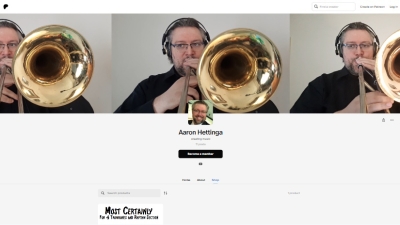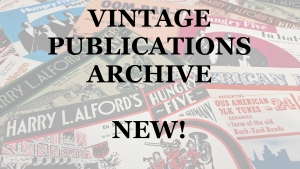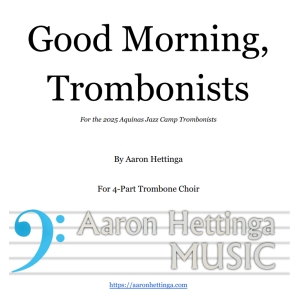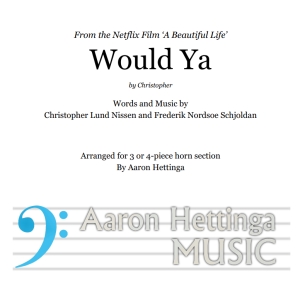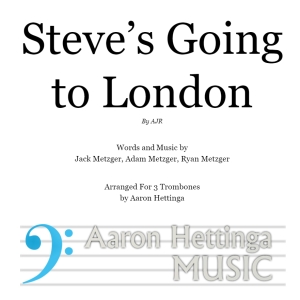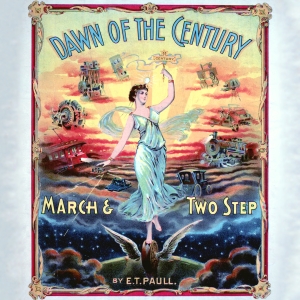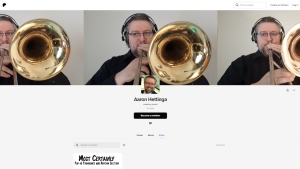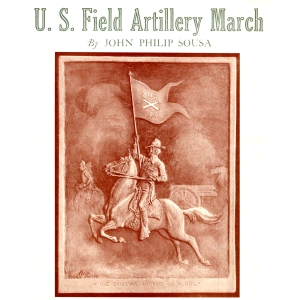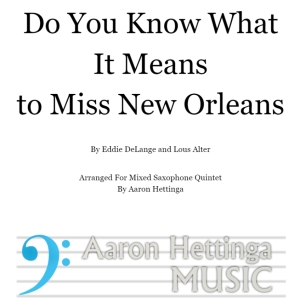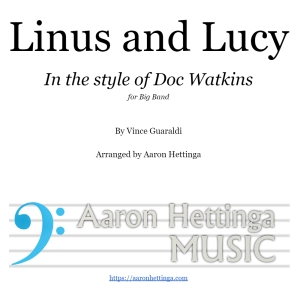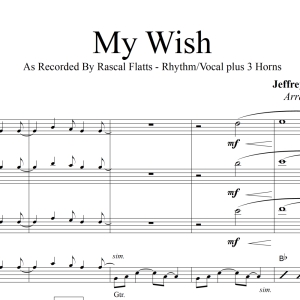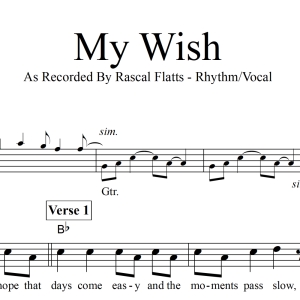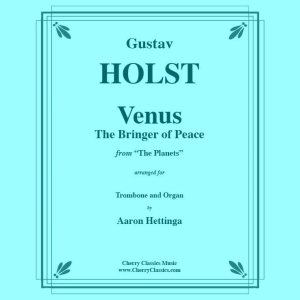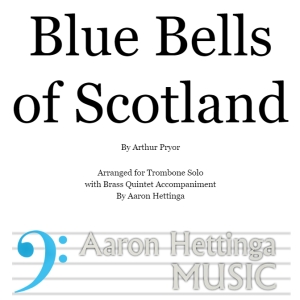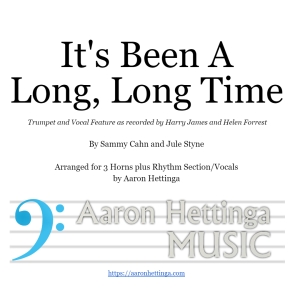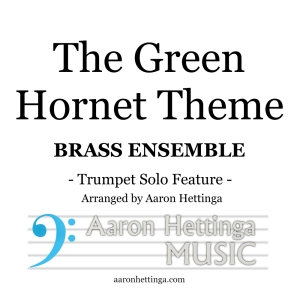
Aaron Hettinga
A new resource has been posted to aaronhettinga.com - a database of all known folios published for small 5-piece German band. This instrumentation (Two Clarinets, Trumpet, Trombone, and Tuba) was a standard complement for Herr Louie’s famous “Hungry Five” band of the 1920s-30s and continues to be a mainstay of small polka groups around the country.
“Good Morning, Trombonists” is a short composition for 4-part Trombone choir and is a piece best used with coffee to start off the day. Featuring jazz-inspired harmonies and independent lines for all parts, this piece makes a great exercise in ensemble playing and intonation.
This composition was written for an ensemble consisting of players at a broad range of skill levels. While intermediate and advancing players should have no difficulty on any part and neither the top nor bottom parts have any strong range demands, the 3rd part is written intentionally to mimic the notes of our daily warm-up.
A special “Thank You” to the trombonists who attended my masterclass at the 2025 Aquinas Jazz Camp. It was a pleasure sharing with you and I’m glad that your involvement helped to spur the origin of this short work. Until next time!
This work is being offered as a FREE download for visitors to this site...just be sure to drop me a message to say "hello" when you get the chance.
I've been having a great time recently sharing a newly-acquired morsel of insight with my musical colleagues. As much as I find value in this new realization and its benefits, I am especially tickled at its peculiar source: my 11-year old son.
This arrangement of Christopher’s song “Would Ya” from the Netflix film ‘A Beautiful Life’ follows the key and form of the original track to make for an exciting live performance! These freestanding horn charts are on the moderate side of the difficulty scale for brass range meant to
be played along with an existing rhythm section. None of the parts have any extreme range demands though they have a bit of rhythmic activity involved.
This arrangement has been prepared in the original key of D major, as recorded. While this chart will function harmonically complete when performed with 3 horns, there is a delicious fullness with the extra low note foundation the Bari Sax provides.
A great addition to your wedding and cover band library!
This fun and exciting song from pop band AJR is arranged here for a trio of 2 Tenor Trombones and Bass Trombone or Tuba but can also be pulled off with any combination of bass clef instruments: Trombones, Baritones/Euphoniums or Bassoons. The form here emulates the beginning of the AJR track with chorus, verse, chorus, then moves ahead to a different sort of trombone jam/playout (beginning at measure 51) which calls out some London-flavored melodies before a restatement of the last phrase of the chorus.
The 1st part keeps the melody throughout this arrangement. There are some lower octave cues in the verse that will allow the player to only have to briefly touch on some F's and G's above the staff a few times if they don’t have a high B-flat at the ready. The remaining parts shoulder the greater technical challenge but also have some simplified cue notes available if needed.
Optionally, if your group prefers not to undertake the brief tempo change (and Rule Britannia! quote) you can optionally skip measures 57 and 58 without slowing, but the chuckle from your audience will surely be worth the extra effort.
Edward Taylor Paull (1858-1924) was an American composer of marches and rags who was successful in producing a large number of circus marches in the late 1800’s/early 1900’s. His “Dawn of the Century March” welcomed in the then-brand new Twentieth Century.
This arrangement has been prepared for the instrumentation of Alford’s “Hungry Five” polka band books and serves as a fine addendum to those familiar pieces. While the clarinet parts tend to be the most active, they often feature diatonic scalar patterns that remain accessible to most intermediate-level players. Though the trumpet part does sneak up to some written high A’s and B-flats during the first strain, the remainder of the piece doesn’t surpass the G on top of the staff. At the risk of sounding sloppy, it may be better to take the tempo a little lesser than a circus march tempo to accommodate. Besides, if playing this piece to accompany Polka dancing, it would be best to take this at a more danceable tempo anyway.
This downloadable PDF package contains a full score and a set of parts that are ready to go for adding some extra variety to your German Band’s Oktoberfest OomPah gig!
Duke Ellington’s enduring standard is presented here in an arrangement for 4 Trombones and Rhythm section (in a lead sheet format).
This arrangement is prepared as a “Head” chart where, after the initial rundown of the melody, the form is repeated for as many soloists as are desired before a final D.C. to play the head once again before ending. Chord changes for the solo section are provided in all parts for flexibility in soloist selection. There’s an optional tag repeat in asterisks near the end of the head as a cue for an easy repeat to take to close this tune out.
The lead trombone part requires high range capability up to a high “C” but all four parts remain reasonably appropriate to their roles in the section. This chart makes for a good opportunity for a trombone quartet to perform this tune in harmony with a rhythm section.
Hi all! There's a recent development on Patreon that should work well with what I have to offer. While my own personal sheet music store here at https://aaronhettinga.com isn't going anywhere, I'm starting to post my sheet music as downloadable PDF files on that platform as an additional storefront for my arrangements. Stay tuned!
Aaron
This arrangement of Steely Dan's “Sign In Stranger” follows the key and form of the original track but brings in some additional horn lines not in the studio version to make for an exciting live performance!
The lead sheet/rhythm chart displays the full vocal lead and lyrics, along with chords and cues for the rest of the rhythm section with chords and slashes only through the solo section and in obvious pauses in the verse. The horn charts are of moderate range or difficulty with nothing in the trumpet part above a written “G” on top of the staff and a high “A” for the trombone.
While written for a band with 4 horns, the Baritone Sax part may be omitted and things will still work out as a 3-horn chart, though it will be important for the Rhythm section to cover the cued bottom notes in the outro. This arrangement has been prepared in the original key of C, as recorded.
A fantastic song to slip into your Steely Dan tribute!
This arrangement of Steely Dan's “Third World Man” follows the key and form of the original track but brings in some additional horn lines not in the studio version to make for an exciting live performance!
The lead sheet/rhythm chart displays the full vocal lead and lyrics, along with chords and cues for the rest of the rhythm section with chords and slashes only through the guitar solo section. The horn charts are of moderate range or difficulty with only a short technical passage in the coda ascending to a written high “C” in the trumpet part.
While written for a band with 4 horns, the Baritone Sax part may be omitted and things will still work out as a 3-horn chart. This arrangement has been prepared in the original key of F minor, as recorded.
A fantastic song to slip into your Steely Dan tribute!
Along with three other arrangers who also work as gigging musicians, I was interviewed by ArrangeMe for their May “Staccato Spotlight” article. ArrangeMe is the platform by which I'm able to publish a number of the works that I have available for sale online and it's pretty great to be singled out like this!
https://blog.arrangeme.com/blog/staccato-spotlight-on-gigging-chamber-musicians
The official U.S. Army song, commonly known as “The Caissons Go Rolling Along” or “The Army Goes Rolling Along,” predates John Philip Sousa’s version by several years. In 1917, Sousa composed “The U.S. Field Artillery March” containing the Caisson Song’s melody as the basis for the march’s TRIO section.
This arrangement makes use of Sousa’s introduction, then remains faithful to his harmonic treatment and the flavors of the melody and accompaniments throughout. While each of the four parts do feature some small technical requirements, they remain at an intermediate level where even less-experienced players should be able to pull them off handily.
While originally scored here for SATB Saxophone quartet, a sub part to play the top line on Alto sax is also included.
This arrangement is a great vehicle to share some patriotic flair on your patriotic Saxophone quartet program!
Note: the live demo recording is made from a brass quintet version of this same basic arrangement.
This Mardi Gras classic is presented here in an arrangement for a Mixed Saxophone Quintet. The melody gets passed back-and-forth a bit to give most everyone a chance at the melody.
Flexibility: Sub parts are included to make for SAATB or AATTB configurations depending on your complement of musicians. The Bari part has lead sheet-style chord changes included in case your player is willing to be a little more free with the New Orleans bass line.
Difficulty: None of the parts are very technically challenging or range-intensive, so a younger group of players shouldn’t need to be intimidated by range requirements. A good vehicle to showcase a great standard!
Note: the recording is made from a brass quintet version of this same basic arrangement.
Also available for Traditional Jazz Ensemble or Piano/Vocal/Guitar or Instrumental Soloist
The timeless sounds of the Vince Guaraldi Trio from the “Charlie Brown Christmas” 1960’s television special was expanded to an exciting rendition recorded by the Doc Watkins big band. This arrangement captures the spirit of that recording and observes the original key of both recordings.
This is an advanced level arrangement where solid high brass ranges are needed. The opening piano part is faithful to the original Guaraldi version, then opens up into latin-flavored open solos section where Trumpet and Trombone soloists can stretch out for a little while. The rhythm section parts are all fully notated other than the solo section, where the initial 2-chord changes of the groove is written out and can be directly repeated thereafter.
There is an open vamp after the trombone solo to allow for an extended percussion feature, yet this can be cut and move directly into the ending instead.
A great way to add this holiday standard onto your program!
Over the course of the past year I've had the privilage of working with so many amazing musicians in a wide variety of ensembles! Now that I'm placing more focus on arranging and publishing, I'm taking every opportunity to capture recordings whenever any of my pieces get read down. Some of these have been finding their way onto my YouTube channel (@AaronHettingaMusic) as follow-score demo videos. A number of these have been either live or in-studio small brass ensemble arrangements (like New Orleans, Muppet Show Theme, Caisson, etc) though there are still a number of multitrack recordings and other live recordings that will continue to make their way out to the YT Channel.
Keep on following/liking/subscribing to the channel to catch these recordings as they make their way out into the world...thanks for listening!
Aaron
The official U.S. Army song, commonly known as “The Caissons Go Rolling Along” or “The Army Goes Rolling Along,” predates John Philip Sousa’s version by several years. In 1917, Sousa composed “The U.S. Field Artillery March” containing the Caisson Song’s melody as the basis for the march’s TRIO section.
This arrangement makes use of Sousa’s introduction, then remains faithful to his harmonic treatment and the flavors of the melody and accompaniments throughout. While each of the four parts do feature some small technical requirements, they remain at an intermediate level where even less-experienced players should be able to pull them off.
While originally scored for 2 Trumpets and 2 Trombones, the bottom voice will work well on Tuba. Horn in F parts are included to substitute for Trumpet 2 or Trombone if needed.
This arrangement is a great vehicle to share some patriotic flair on your program when four brasses are available!
This arrangement of Rascal Flatts coming-of-age song “My Wish” adds a three piece horn section to fill up a live performance and enhance the core rhythm section. This can really elevate a live performance! These horn parts fit right in with the style of the recorded version, following the form of the original track to add some extra depth.
This arrangement has been prepared in the original key of E, as recorded.
A fantastic song and frequent request for Weddings and Graduations alike!
Also available as Lead Sheet only
In D: Lead Sheet, 3-piece and 5-piece horn sections
In F: Lead Sheet, 3-horn and 5-horn versions
This lead sheet includes melody, lyrics and chords for Rascal Flatts ever popular coming-of-age song, My Wish. A fantastic song for Weddings and Graduations alike!
In the key of E Major, the original recorded key.
Also available as with 3-piece Horn Section
In D: Lead Sheet, 3-piece and 5-piece horn sections
In F: Lead Sheet, 3-horn and 5-horn versions
I'm proud to announce that this arrangement has been published through Cherry Classics!
Gustav Holst's "Planets" suite for symphony orchestra has long been a favorite. From the amazing use of orchestral colors to the exciting parts written for trombones in the Mars and Jupiter movements, it's everything a young low brass musician would love.
Over time, I came to appreciate the Venus movement above all the others, yet knew there would never be a practical reason for a trombonist to play the beautiful horn solo that opens it. After many years of work on this arrangement for solo trombone and organ, there's finally an opportunity to present this amazing work while still respecting the form of Holst's work. In preparing this piece, a key objective was to keep from abridging the work's length at all, as well as making sure all of the most important melodic and harmonic elements remain present.
This piece will reward an advanced soloist with a strong and lyrical high register.
While the title may seem unfamiliar, your audience will light up upon reaching the TRIO when they realize that you’re playing the yodeling theme music from The Price Is Right’s “Cliff Hangers” game! This traditional swiss tune is presented here in an arrangement for the instrumentation of Alford’s “Hungry Five” series of Polka band books.
Each of the 5 parts receives a moment or two to shine, either to take a run at the melody, counter lines, or other figures of interest. The tuba part is mostly in its straightforward support roles, but there are some small technical challenges throughout the rest of the ensemble that will reward advancing players as well as audiences for your German band.
As a performance option, you may want to consider doing a complete D.C. al Fine to extend the performance time if a single pass doesn’t seem enough.
Ready to go for your Oktoberfest OomPah gig!
Arthur Pryor’s famous theme and variations on “The Blue Bells of Scotland” has been a showcase for trombonists with strong technique and agility for well over a century. While this work is most commonly performed as accompanied by a wind band or with piano, in this arrangement the soloist is supported by a standard brass quintet.
The solo part is unchanged from Pryor’s original, though there are some minor tweaks to suggested slide positions and other notations throughout. While each of the accompanying quintet parts do feature some small technical requirements, they remain at an intermediate level where even less-experienced players should be able to pull them off.
Performance suggestion: as an option, it’s recommended to utilize Cornets and Euphonium in place of the Trumpet and Trombone parts in the accompanying quintet to more faithfully emulate the sounds of the conical-bore instruments of the period and to better separate the tonality of the accompaniment from the soloist.
This arrangement is a great vehicle to showcase a talented trombonist on this classic piece of standard trombone literature!
The enduring World War II- era standard “It's Been A Long, Long Time” has been recorded by many great artists through the years. More recently, the song has found renewed popularity due to its use in the Marvel Cinematic Universe’s “Avengers” movies. This arrangement takes its cue from the recording by Harry James and his orchestra, and reworks the performance as presented here for Vocal soloist, 3 horns, and Rhythm section. This chart observes the original key and form of the classic recording by Harry James with vocal soloist Helen Forrest.
The horn parts closely follow in the footsteps of the original recording, making this a good vehicle to showcase a talented trumpeter. The remaining horns play the supporting role of the most important elements of the large orchestra arrangement which requires strong players on all parts.
The Rhythm section/Lead sheet incorporates the chord changes and most important rhythmic elements to allow a flexible instrumentation of rhythm section to adequately feature the trumpeter and vocalist.
This arrangement is a great way to showcase talented instrumentalists and vocals on this classic piece of music!
This arrangement gives a horn section a chance to beef up a performance of "Semi-Charmed Life" by Third Eye Blind. This horn chart follows the form and key of the original track to bring some extra support to the vocal harmonies while making use of an existing rhythm section (rhythm section parts not included in this package).
Really lifts up a live performance!
The trumpet solo made famous by Al Hirt of “The Green Hornet Theme” (and more recently revived with its inclusion in the Quentin Tarantino motion picture “Kill Bill”) is presented here as a feature for a talented trumpet soloist to be accompanied by an additional 6 brass plus a rhythm section of piano and percussion. This arrangement observes the original key and form of the classic recording.
While the trumpet solo sticks to the original performance, the remaining brass parts step up to fill in for the remainder of the big band accompaniment. The Piano and Drum Set parts are all fully notated. The xylophone part is optional, as is the Timpani/Tambourine percussion part, but both add a nice bit of sparkle to the proceedings.
This is an advanced level arrangement that showcases a virtuoso trumpeter as supported by a solid ensemble.
A great way to add some 60’s television theme flavor onto your program!



